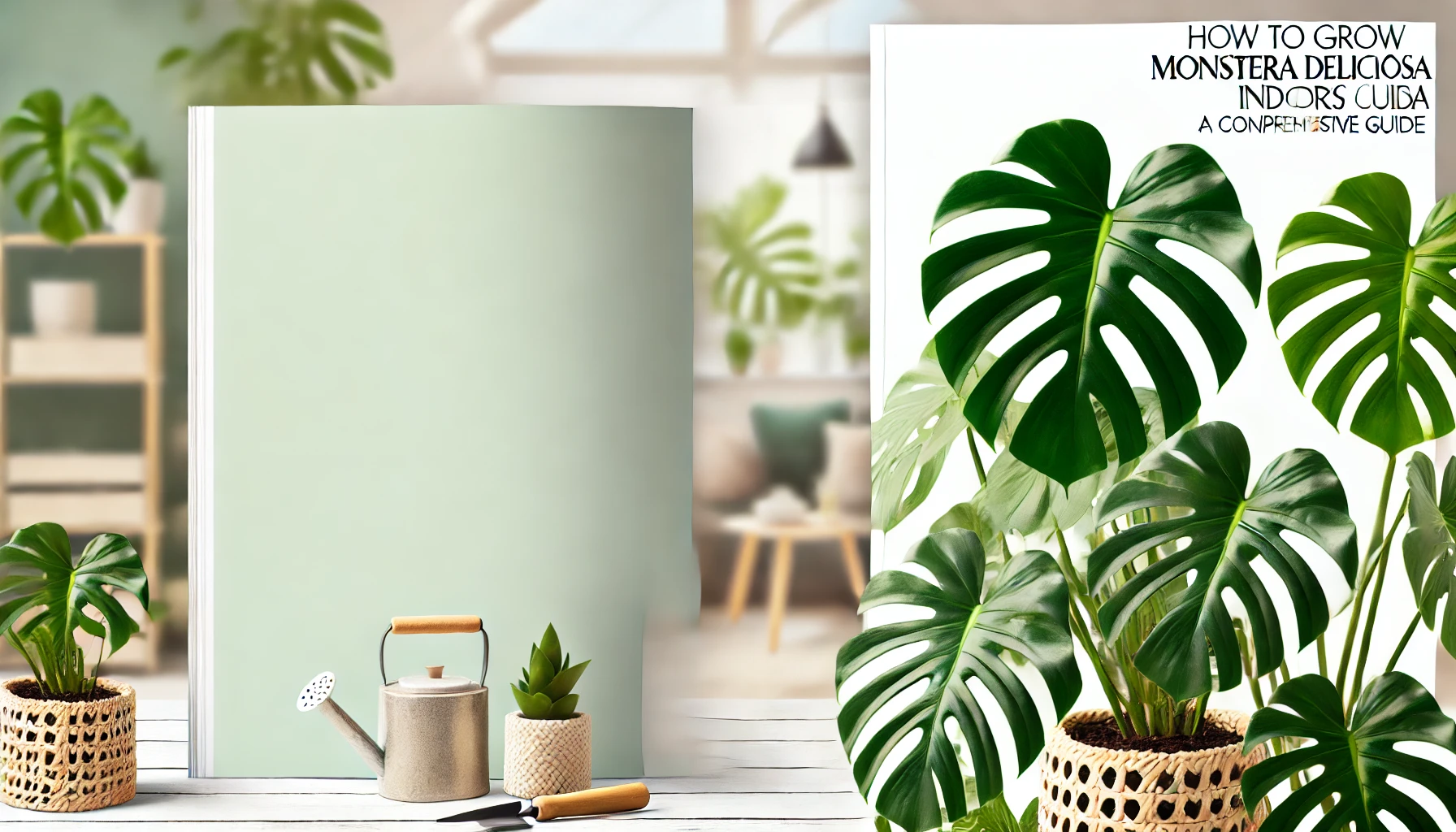Monstera Deliciosa, commonly known as the Swiss Cheese Plant or simply Monstera, is a tropical plant native to the rainforests of Central and South America. Its iconic, large, glossy leaves with distinctive holes and splits make it a favorite among indoor plant enthusiasts and gardeners alike. Beyond its striking appearance, Monstera Deliciosa offers various benefits, from air purification to potential health advantages. This plant is not only a visual delight but also relatively easy to care for, making it an excellent choice for both novice and experienced plant lovers. In this article, we will explore the fascinating characteristics, care tips, and the growing popularity of Monstera Deliciosa, uncovering why it has become a beloved addition to homes and offices around the world.
Table of Contents:
- History and Origins Monstera Deliciosa
- Benefits of Monstera Deliciosa in our life
- How to Grow Monstera Deliciosa
- Pests and Disease Control
- Harvesting and Preservation
History and Origins Monstera Deliciosa
Monstera Deliciosa, also known as the Swiss Cheese Plant, boasts a rich history deeply rooted in the lush rainforests of Central and South America. Belonging to the Araceae family, this iconic tropical plant is celebrated for its large, glossy leaves adorned with natural splits and holes, resembling intricate patterns akin to Swiss cheese.
History and Origins
Native to the tropical rainforests of southern Mexico, Guatemala, and parts of Central America, Monstera Deliciosa thrives in warm, humid climates with filtered sunlight. It was first scientifically described by Swedish botanist Carl Linnaeus in the 18th century, who marveled at its unique leaf structure and distinctive fruiting habits. The name “Monstera” derives from the Latin word “monstrum,” referring to the unusual appearance of its leaves, while “Deliciosa” highlights the deliciousness of its edible fruit.
Cultural Significance
In its native habitat, Monstera Deliciosa holds significant cultural importance. The plant not only provides essential habitat and food for various wildlife but also offers edible fruits that are prized for their sweet, pineapple-like flavor when ripe. Locals have long harvested these fruits as a delicacy, contributing to the plant’s cultural and culinary heritage.
Global Appeal
Across the globe, Monstera Deliciosa has garnered widespread popularity as a cherished houseplant and decorative accent for indoor spaces. Its robust nature and striking foliage make it a favorite among plant enthusiasts, interior designers, and social media influencers alike. The plant’s ability to adapt to various light conditions and relatively low maintenance requirements further enhance its appeal, making it suitable for both homes and offices.
Growing Popularity
With the advent of social media and online plant communities, Monstera Deliciosa has experienced a resurgence in popularity. Its photogenic leaves and tropical charm have made it a staple on platforms like Instagram, where plant lovers showcase their thriving specimens and share care tips. The plant’s enduring allure lies not only in its aesthetic beauty but also in its accessibility and resilience as an indoor plant option.
Conclusion
As you embark on your journey with Monstera Deliciosa, you’re not merely acquiring a plant; you’re embracing a piece of botanical history and cultural significance. Whether you’re captivated by its origins, intrigued by its unique leaf structure, or simply drawn to its lush greenery, Monstera Deliciosa promises to enrich your indoor garden with elegance and charm.
Explore more about caring for your Monstera Deliciosa and discover why this tropical treasure continues to captivate plant enthusiasts worldwide. Stay connected with [Your Blog Name] for expert insights, practical tips, and inspiration to cultivate and enjoy your Monstera Deliciosa to its fullest potential.
Benefits of Monstera Deliciosa in our life
Monstera Deliciosa, a popular houseplant known for its striking, perforated leaves, offers numerous benefits both as a decorative indoor plant and through its edible fruit. In addition to enhancing indoor aesthetics and air quality, it also provides nutritional value when its fruit is consumed. Let’s explore how this remarkable plant can positively impact our homes and health.
Benefits of Monstera Deliciosa Plant
- 1. Air Purification: Monstera Deliciosa is known for its ability to purify the air. It absorbs pollutants such as formaldehyde, benzene, and trichloroethylene, thereby improving the indoor air quality. This makes it an excellent addition to homes, especially in urban areas with higher levels of pollution.
- 2. Aesthetic Appeal: The large, glossy, and uniquely perforated leaves of the Monstera Deliciosa add a touch of elegance and greenery to any indoor space. Its striking appearance makes it a favorite choice for interior decoration, enhancing the overall ambiance of living rooms, offices, and other indoor environments.
- 3. Humidity Regulation: As a tropical plant, Monstera Deliciosa contributes to maintaining humidity levels indoors. It releases moisture into the air through a process called transpiration, which can be particularly beneficial in dry climates or during winter when indoor air tends to be drier.
- 4. Mental Health Benefits: Having greenery indoors has been shown to reduce stress and anxiety levels. Monstera Deliciosa, with its lush foliage, can create a calming environment, promoting mental well-being and enhancing mood.
- 5. Low Maintenance: Monstera Deliciosa is relatively easy to care for, making it an ideal plant for both novice and experienced plant enthusiasts. Its resilience and adaptability to indoor conditions mean it requires less frequent watering and can thrive in a variety of lighting conditions.
Benefits of Monstera Deliciosa Fruit
- 1. Nutritional Value: The fruit of the Monstera Deliciosa, often referred to as the “Mexican Breadfruit” or “Ceriman,” is rich in essential nutrients. It contains vitamin C, which supports immune function, and potassium, which is important for heart health and regulating blood pressure.
- 2. Antioxidant Properties: The fruit is packed with antioxidants that help combat free radicals in the body. These antioxidants can reduce oxidative stress, potentially lowering the risk of chronic diseases and promoting overall health.
- 3. Digestive Health: Monstera Deliciosa fruit is known to aid in digestion. It contains dietary fiber, which helps maintain healthy bowel movements, prevent constipation, and support a healthy digestive system.
- 4. Energy Boost: The natural sugars present in Monstera Deliciosa fruit provide a quick source of energy. Consuming the fruit can help rejuvenate the body, making it a good option for a natural energy boost.
- 5. Unique Flavor: The fruit of the Monstera Deliciosa has a unique and delicious flavor, often described as a combination of pineapple and banana. This makes it a delightful and exotic addition to various dishes, smoothies, and desserts, adding a tropical twist to your diet.
Incorporating Monstera Deliciosa into your home and diet offers a range of benefits, from enhancing your living space to providing nutritional value, making it a truly versatile and beneficial plant.
How to Grow Monstera Deliciosa
Growing Monstera Deliciosa is a rewarding experience for plant enthusiasts. Known for its distinctive, hole-filled leaves, this tropical plant thrives in indoor environments with proper care. Whether you’re a novice or an experienced gardener, Monstera Deliciosa’s resilient nature and striking appearance make it an excellent addition to any home. In this guide, we’ll explore the essential tips and techniques for successfully cultivating this popular houseplant, ensuring it flourishes and adds a touch of exotic beauty to your living space.
Ideal Container size for Monstera Deliciosa
Choosing the right container is crucial for the health and growth of your Monstera Deliciosa. Opt for a pot with:
- Size: Large enough to accommodate root growth, with drainage holes to prevent waterlogging.
- Material: Preferably ceramic or plastic to retain moisture while allowing roots to breathe.
- Depth: At least 10-12 inches (25-30 cm) deep to support its climbing nature.
Ideal Weather Conditions
| Condition | Ideal Range |
|---|---|
| Light | Bright, indirect sunlight |
| Temperature | 65-85°F (18-29°C) |
| Humidity | 60-80% |
| Soil Moisture | Moderately moist, well-draining |
These conditions mimic its native tropical habitat, ensuring robust growth and potential fruiting.
How to Propagate Monstera Deliciosa (From Seed or Cutting)
Propagation Methods
Monstera Deliciosa can be propagated through seeds or stem cuttings:
- 1. From Seeds:
- Collect fresh seeds from ripe Monstera Deliciosa fruits.
- Prepare a seed-starting mix of equal parts peat moss, perlite, and coarse sand.
- Sow seeds 1 inch (2.5 cm) deep in small pots or seed trays.
- Keep the soil consistently moist and maintain high humidity by covering with plastic or using a humidity dome.
- Seeds typically germinate within 2-4 weeks.
- 2. From Stem Cuttings:
- Select a healthy stem with a node (where leaves attach) and aerial roots if possible.
- Cut just below a node with a clean, sharp knife.
- Optionally, dip the cut end in rooting hormone to encourage root growth.
- Plant the cutting in a well-draining potting mix and keep the soil lightly moist.
- Place in a warm, bright location with indirect sunlight.
Growing Stages
| Stage | Description |
|---|---|
| Germination | Seedling emergence from soil |
| Seedling Stage | Initial leaf development |
| Vegetative Growth | Vine elongation and leaf maturation |
| Flowering | Rare indoors; inflorescence develops |
| Fruit Development | Fruit formation begins |
| Ripening | Fruit matures and ripens |
Soil Mix for Planting Seed or Cuttings
Prepare a well-draining potting mix suitable for Monstera Deliciosa:
- Ingredients:
- 50% peat moss or coconut coir for moisture retention.
- 30% perlite or coarse sand for drainage.
- 20% compost or well-aged organic matter for nutrients.
Monstera Deliciosa Care for Each Stage of Growth
- Germination and Seedling Stage:
- Watering: Keep the soil consistently moist but not soggy. Use a spray bottle to mist the soil surface to maintain humidity.
- Light: Provide indirect sunlight or use grow lights for 12-14 hours daily to support seedling growth.
- Temperature: Maintain a warm environment (around 70-75°F or 21-24°C).
- Fertilizing: Once seedlings have true leaves, feed them with a diluted liquid fertilizer like Miracle-Gro All Purpose Plant Food, applied every 4-6 weeks.
- 2. Vegetative Growth:
- Light: Place in bright, indirect sunlight. Avoid direct sun, which can scorch leaves.
- Watering: Water when the top inch of soil feels dry, allowing excess water to drain. Ensure the pot has drainage holes.
- Humidity: Maintain moderate to high humidity (60-80%). Mist leaves occasionally or use a humidity tray.
- Fertilizing: Feed monthly with a balanced, water-soluble fertilizer such as Osmocote Indoor/Outdoor Plant Food during the growing season (spring and summer). Reduce in fall and winter.
- 3. Flowering and Fruit Development:
- Environmental Stability: Ensure stable conditions with consistent temperature and humidity.
- Pollination (if applicable): Assist with hand pollination using a soft brush or cotton swab.
- Fertilizing: Switch to a bloom booster fertilizer like Espoma Organic Bloom for flowering and fruiting stages. Apply as directed.
- 4. Ripening:
- Monitoring: Check fruits regularly for ripeness indicators like color change and slight softening.
- Harvesting: Gently twist or cut mature fruits from the vine using clean, sharp scissors or pruners.
- Storage: Store harvested fruits at room temperature in a cool, dry place. Avoid refrigeration.
General Tips:
- Pruning: Trim yellow or damaged leaves regularly to promote healthy growth using clean pruning shears.
- Pest Control: Inspect regularly for pests like spider mites or aphids. Treat infestations promptly with insecticidal soap or neem oil, following package instructions.
Common Pests and Diseases of Monstera Deliciosa: Identification, Cure, and Prevention
Monstera Deliciosa, with its iconic perforated leaves, is a beloved houseplant, but it is not immune to pests and diseases. Common issues include spider mites, mealybugs, scale insects, and aphids, as well as diseases like root rot, leaf spot, anthracnose, and powdery mildew. Identifying and addressing these problems promptly is crucial for maintaining the plant’s health and aesthetic appeal. In this guide, we will explore the identification, cure, and prevention of these common pests and diseases, ensuring your Monstera Deliciosa remains vibrant and thriving.
Pests of Monstera Deliciosa:
- 1. Spider Mites
- Identification: Look for tiny, moving dots on the undersides of leaves and fine webbing. Leaves may appear speckled or yellowed.
- Cure: Spray the plant with a mixture of water and mild soap, or use neem oil. In severe cases, use an appropriate miticide.
- Prevention: Keep humidity levels high, regularly mist the plant, and ensure good air circulation. Inspect plants frequently for early signs.
- 2. Mealybugs
- Identification: White, cotton-like masses on leaves, stems, and leaf joints.
- Cure: Remove with a cotton swab dipped in rubbing alcohol. Use insecticidal soap or neem oil for larger infestations.
- Prevention: Regularly inspect plants, avoid over-fertilizing, and isolate new plants before introducing them to your collection.
- 3. Scale Insects
- Identification: Small, oval, brown or tan bumps on stems and leaf undersides.
- Cure: Manually remove scales with a cloth dipped in soapy water or use insecticidal soap. For severe infestations, apply systemic insecticides.
- Prevention: Maintain plant health through proper watering and feeding, and inspect regularly to catch infestations early.
- 4. Aphids
- Identification: Small, soft-bodied insects that cluster on new growth. Presence of sticky honeydew and sooty mold.
- Cure: Spray plants with water to dislodge aphids, use insecticidal soap, or neem oil. Ladybugs can also be introduced as natural predators.
- Prevention: Regularly inspect new growth, avoid over-fertilizing, and introduce beneficial insects like ladybugs.
Diseases of Monstera Deliciosa:
- 1. Root Rot
- Identification: Brown, mushy roots with a foul smell. Wilting or yellowing leaves.
- Cure: Remove the plant from its pot, cut away affected roots, and repot in fresh, well-draining soil. Reduce watering frequency.
- Prevention: Ensure pots have drainage holes, use well-draining soil, and allow the top inch of soil to dry out between waterings.
- 2. Leaf Spot
- Identification: Brown or black spots on leaves, often with yellow halos.
- Cure: Remove affected leaves and apply a fungicide. Ensure leaves are dry before nightfall.
- Prevention: Improve air circulation, avoid overhead watering, and reduce humidity around the plant.
- 3. Anthracnose
- Identification: Dark, sunken lesions on leaves and stems.
- Cure: Prune and discard infected plant parts. Apply a copper-based fungicide.
- Prevention: Increase air circulation, avoid water splashing on leaves, and keep the plant area clean.
- 4. Powdery Mildew
- Identification: White, powdery coating on leaves.
- Cure: Remove affected leaves and treat with a fungicide or a mixture of baking soda and water.
- Prevention: Reduce humidity, ensure good air circulation, and avoid overcrowding plants.
By following these identification, cure, and prevention methods, you can keep your Monstera Deliciosa healthy and thriving, free from common pests and diseases.
How to Harvest Monstera Deliciosa Fruit
Harvesting Monstera Deliciosa fruit requires careful attention to ensure optimal flavor and preservation of the plant’s health:
- Timing: Wait until the fruit’s scales (hexagon patterns) begin to lift and expose the edible flesh inside. The fruit should also give off a slightly sweet aroma.
- Harvesting: Use clean, sharp scissors or pruning shears to cut the fruit stem carefully from the plant. Avoid twisting, as this can damage the vine.
- Handling: Handle the fruit gently to prevent bruising or damage. Monstera Deliciosa fruit can be fragile when ripe.
How to Preserve Monstera Deliciosa Fruit
Preserving Monstera Deliciosa fruit ensures it stays fresh and flavorful for longer periods:
- Ripening: Allow harvested fruit to ripen fully at room temperature. Once ripe, consume or proceed with preservation methods promptly.
- Refrigeration: Store ripe fruit in the refrigerator in a perforated plastic bag to maintain humidity levels. This helps extend its shelf life for up to a week.
- Freezing: For longer-term preservation, you can freeze pieces of ripe fruit. Simply peel, remove seeds, and cut into desired sizes before freezing in an airtight container.
Tips and Tricks for Better Yield
To maximize the yield and health of your Monstera Deliciosa plant:
- Supportive Environment: Provide consistent care with adequate light, temperature, and humidity levels to encourage fruit production.
- Fertilization: Use a balanced fertilizer during the growing season to promote healthy growth and fruit development. For instance, apply a slow-release fertilizer such as Miracle-Gro Shake ‘n Feed.
- Pruning: Regularly prune dead or yellowing leaves and trim overcrowded vines to redirect the plant’s energy towards fruiting.
- Pollination Assistance: If growing conditions permit, assist with hand pollination using a soft brush to transfer pollen between flowers. This can enhance fruit set.
- Pest Control: Monitor for pests such as aphids or spider mites, which can affect fruit quality. Treat infestations promptly with organic insecticides like neem oil.
By following these tips on harvesting, preserving Monstera Deliciosa fruit, and maximizing yield, you can enjoy a rewarding experience cultivating this exotic plant indoors. Whether you’re a novice or experienced gardener, these practices will help maintain the health and productivity of your Monstera Deliciosa plant.



